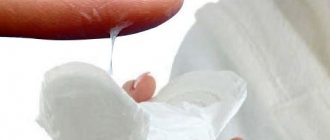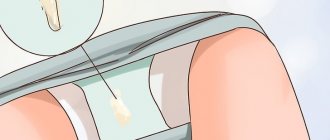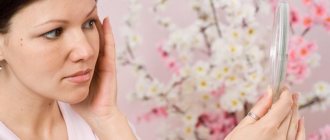What kind of discharge can there be?
In order to understand the nature of the discharge in newborn girls and whether they pose a danger to the child’s health, it is recommended to take into account age. In the first week the following are typical:
- Bloody (go away on their own 2-3 days after the onset);
- Orange;
- Yellow;
- Pink.
In most cases, they resolve without treatment. This will take no more than a week (the period of establishing the power supply system). White or completely transparent discharge is also noted. Their nature is due to the fact that a residue of vernix lubricant is present in the baby’s body. If no inflammatory or other pathological processes are observed, over time they will disappear on their own.
White discharge in girls
Sometimes parents notice an accumulation of cheesy formations. They are located in the folds of the labia. You should not be afraid of this, since this is a natural reaction of the body to new circumstances. There is a response from the vaginal walls to the formation of hormones: prolactin and progesterone. A large amount of these hormones is contained in the milk that the baby is fed immediately after birth.
Important! You should not use special products to remove discharge. It is enough to carry out standard hygiene procedures. The complete disappearance of such problems is observed after 2-4 weeks.
A good mood and a smile indicate the absence of significant health problems
White vaginal discharge in newborn girls is normal. This is due to the fact that their body actively gets used to and adapts to new living conditions. Restructuring sometimes happens too quickly. Biological substances - hormones, have an increased influence on all processes that may occur in a baby after birth. It is the crisis associated with hormones that causes an increased amount of white discharge. First, the release occurs in the mother (during childbirth), then the hormones penetrate into the baby’s blood with milk. During this period, the baby may experience not only white discharge, but also slight swelling of the nipples.
Gray color
Discharge colored in a similar shade in a baby girl indicates that a disorder associated with the balance of microflora is occurring in the child’s body. In this case, the consistency of the discharge resembles a cream. There is no need to worry if the problem lasts no more than 3 days. Also, there should not be an unpleasant odor or a darker color change.
Doctors record that up to 70% of newborn girls go through similar problems. Grayish and liquid discharge indicates the presence of desquamative vulvovaginitis. The problem disappears completely within 3 days after the baby is born.
Yellowish from the genitals
Such discharge in newborn baby girls is a consequence of the presence of a problem such as uric acid crisis. It occurs when the body gets rid of excess salts.
Must be taken into account! Even a boy can encounter this phenomenon.
Visually, the discharge may be yellowish, rich in color, or orange. No special treatment is required. The genital organ should be cleaned using normal hygiene procedures. In the first month the problem disappears.
Light and transparent
If you have light, transparent discharge that foams a little, you should consult your doctor. This usually indicates the development of a trichomonas infection. Light watery ones indicate that allergic vulvovaginitis is occurring. They appear when the mucous membrane is very thin or dry. In this case, you need to carefully care for the child and regularly carry out hygiene procedures.
Bloody vaginal discharge in infants
Sometimes vaginal discharge with blood in a baby can be detected after birth or a few days later. The bloody substrate that appears can be of two types:
- Partially bloody with grayish-white;
- Bloody discharge with a yellow tint.
They appear in 8% of all cases recorded by doctors. The time when they can begin is a week from birth. Duration – 1-2 days. The main reason for its occurrence is a sudden cessation of the action of the maternal hormone estrogen. No special treatment is required. In order to remove the discharge, you need to wipe the baby with warm water. This will prevent possible infection from entering the body. In this case, severe bleeding does not occur.
Important! The condition of the mucous membranes and cervix in the child will be the same as during normal menstruation.
Girl's secrets
Hygiene of newborn girls also includes constant monitoring of the condition of the genital organs. The baby's tiny body has a huge number of glands, and the secretion they secrete can be an excellent platform for the development of pathogenic microflora.
Intimate hygiene of a newborn girl comes down to constant inspection and cleansing of the genital area if necessary. If you find that the labia are stuck together with secretions, you need to carefully move them apart with a damp cotton swab, remove the secretions and then dry them with a napkin. Failure to keep this area clean can lead not only to inflammatory processes, but also lead to the formation of adhesions of the labia.
Intimate hygiene of newborn girls comes down to caring for the external genitalia. The internal organs are very delicate and vulnerable, so you need to make sure that water does not get there at the time of washing. This can cause an inflammatory process. Girls should be washed by placing them on their backs, and try to avoid washing in basins or bathtubs at first.
If you find that your baby has inflammation, strange discharge and a fever, you should immediately seek help from a specialist.
The difference between normal discharge and pathological discharge
How often does a newborn eat in the first days of life?
If this is the norm, then the discharge should not be brightly colored (green, red and other shades). There is also no smell. Ingredients: mucus without impurities. Opacity is normal. The secretion may sometimes contain small inclusions. Excessive discharge is excluded. There are no deviations if there is a small amount of mucus, epithelial or skin cells.
Microorganisms may also be present in the discharge. In most cases, these are fermented milk sticks and lactobacilli. They will always be present, regardless of whether a baby girl, a girl or a woman will be tested for the composition of the flora.
Blood cells are red blood cells or white blood cells. The indicator increases if the baby faces a problem such as a hormonal crisis. In this case, the discharge is colored red or pink. Usually the next day or after 2 days the problem disappears if there are no pathological changes.
White discharge in newborn girls: causes and what to do? Hygiene of newborn girls
A small child requires maximum attention from adults.
After all, he has found himself in a world completely alien to him and it will take a lot of time before he adapts to it. And now the baby is very vulnerable and requires special care with daily hygiene. The baby's nose is cleaned, its eyes are washed, and it is washed.
Pediatric doctors advise examining the child daily, paying special attention to the groin and skin folds. This is especially true for girls.
More articles related to your question
- Exercise therapy for infants: goals, rules, features of gymnastics
- Properly washing a newborn: tips for mothers of boys and girls
- Features of caring for a newborn baby in the first year of life
- Herpes in a newborn: symptoms, causes, types and treatment
- The baby's eyes are festering: the main reasons and ways to help
- Lactation mastitis: from causes to treatment
Newborn girls experience vaginal discharge. And this, according to doctors, is not something to be afraid of. This is not a pathology, this is the norm for a newborn. Experts call this phenomenon a sexual crisis.
Causes of genital discharge in newborn girls
First of all, you need to decide on the shade of the liquid. The discharge may not always be pure white. Sometimes they are greenish, brownish or even bloody. Depending on this, you can roughly determine the reason for their appearance.
Usually the appearance of such liquid greatly frightens the baby’s parents, some even begin to believe that the girl has started menstruation. But this is not typical for newborns.
Therefore, it is worth considering the real causes of unpleasant symptoms depending on the age of the child.
Sexual crisis in newborns
Sexual (hormonal) crisis in newborns is a process of cleansing and adaptation of the child’s body to the external environment. During the first days (weeks), the newborn’s body is cleansed of excess estrogen (maternal hormones). This process can begin in the maternity hospital and last from 2 to 8 weeks. The hormonal crisis reaches its peak by the end of the first week.
This process can occur in both the body of a girl and a boy, or it may not occur at all. The main symptom of a sexual crisis is engorgement of the mammary glands, often accompanied by discharge like colostrum. You cannot take any measures about this yourself, especially squeezing out the liquid.
Also, a sexual crisis manifests itself in the form of:
- acne;
- swelling;
- swelling of the genital organs (in boys);
- vaginal discharge of various colors and consistency (in girls).
The last of these signs especially frightens young parents, since it manifests itself most clearly. The discharge can be: light, transparent, whitish, yellowish, bloody.
In the first month of life
It may seem surprising, but discharge in newborn girls in the first days is considered normal. In this case we are talking about a liquid that resembles leucorrhoea. They are a whitish liquid coating that forms between the folds of the labia.
Almost all women face this. Of course, this should not happen to children. The only exceptions are newborn girls under 1 month of age. As a rule, after 4-6 weeks the symptoms go away on their own.
At this time, it is enough to adhere to hygiene measures, and everything will be fine.
What kind of discharge can a baby girl have?
If you notice discharge from your newborn daughter, pay attention to the baby’s age.
In the first days of life
The first days of life are characterized by:
- bloody discharge in a newborn girl. They go away on their own within 2-3 days;
- orange, yellow, pink. A uric acid crisis is characteristic of the early period of life and disappears by the end of the first week after birth, as soon as the mother establishes breastfeeding;
- ordinary mucous membranes resembling leucorrhoea. These are remnants of the original lubricant, which will clear up on its own over time.
Clean and dry
At 1 month
At 1 month of age, a girl's leucorrhoea, resembling a white sticky coating between the folds of the labia, is considered normal. This is a condition that does not require treatment and usually goes away on its own by 6-8 weeks of life.
2 month
By the second month, the discharge in infants should go away. If the white, cheesy buildup does not go away by week 8, your baby should be taken to the doctor.
3 month
Discharge found in a 3-month-old baby may indicate ongoing inflammatory processes, and therefore require consultation with a pediatric gynecologist. It could be:
- bacterial vulvovaginitis. Accompanied by redness and not abundant yellow discharge;
- vulvovaginitis provoked by enterobiasis. Worms bring pathogenic microbes from the intestines into the vagina - enterococcus and E. coli;
- foreign body in the vagina - toilet paper, threads, etc. As a result, the walls of the vagina are damaged and inflammation develops;
- exudative diathesis. This chronic disease can provoke vulvar hyperemia and dry mucous membranes;
- candidiasis - curdled white discharge may appear against the background of herpes, trichomoniasis;
- Trichomonas. Infection is possible through household means or during childbirth. Accompanied by copious foamy discharge.
Restless babe
If the child is 3 months or older
If parents notice white discharge in a newborn girl, this is normal, but in the third month of life this may be the first sign of an inflammatory process in the baby’s body. Therefore, you should not postpone your visit to the pediatric gynecologist. Most often at this age, unpleasant symptoms appear against the background of:
- Bacterial vulvovaginitis. However, in this case, the girl’s discharge will not be white, but yellow. Redness may be noticeable in the groin area.
- Vulvovaginitis caused by enterobiasis. In this case, we are talking about worms that transferred pathogenic microorganisms from the child’s intestines to the vagina.
- Entry of a foreign body into the vagina. These could be pieces of toilet paper, threads and much more. This may well cause damage to the child's vagina and lead to serious inflammation.
- Exudative diathesis. This pathology is classified as chronic. This condition can lead to vulvar hyperemia. This causes dryness of the vaginal mucous membranes.
- Candidiasis. Such manifestations can also occur against the background of herpes. It may well provoke the appearance of white discharge in newborn girls and older babies.
- Trichomonas. A newborn baby can become infected through the birth canal, and an older girl can become infected through household means. In this case, the discharge will be more foamy.
It is also worth considering one of the most common reasons for the appearance of white mucous discharge in a newborn girl.
When is treatment needed?
Treatment for a child can only be prescribed by a doctor. In this case, an individual approach should be taken, taking into account the girl’s age and the presence of any chronic diseases.
Source: https://PlastikaPlus.ru/matka/slizistye-vydeleniya-u-novorozhdennoj-devochki.html
Is it necessary and how to clean it?
What does a child need in the first months of life - list
If mucus begins to stand out, you need to carefully remove it. Rinse with regular warm water. It is allowed to add only children's hygiene products that are age appropriate.
The female body, regardless of age, needs proper hygiene. The basics of all activities are moderation and careful actions. The main task of parents in the process of caring for a child is to preserve the natural protective barriers that exist on the mucous membranes. That is why it is important to follow simple rules of care:
- There is no need to use soap every time (only to remove mucus).
- The washing process should go like this: the child should lie with his back on a half-bent arm, wash from top to bottom (so that water with secretions does not get into the perineum).
- There should be no dyes in soap and other care products.
- Before the main bath, you need to wash the girl.
It is recommended to use soap (even baby soap) no more than 1-2 times a week. It is also necessary to carefully remove feces from the perineum (especially greenish ones, rinse twice, as they may contain microorganisms). After taking water procedures, you should not wipe your perineum with a towel. It is best to gently blot the area with a soft, clean cloth.
Herbal decoctions are not added to the bath during bathing.
Important! There is no need to add decoctions of herbs and plants to the water for washing. They can cause an allergic reaction.
Washing
Babies can relieve themselves up to 20 times a day, so the hygiene of a newborn girl must be observed very carefully. At such a tender age, the skin and mucous membranes are very vulnerable, and the slightest excessive exposure to moisture and feces can cause irritation, redness, rash and infection.
After each small hike, you need to thoroughly dry your skin, and after bowel movement, wash it with warm water. You should wash your child only after the bulk of the dirt has been removed with a napkin. All babies are washed strictly from front to back, to avoid contamination of the genitals. Afterwards you need to blot the moisture with a napkin. You should not rub your delicate skin with a towel; such manipulations will quickly lead to irritation. If irritation occurs, apply sterile oil or powder to them.
What should parents do?
If white watery discharge appears in newborn girls or other types, the first thing parents need to do is to objectively assess the situation. In most cases, the process is fully consistent with physiology and indicates normal reactions for the body.
Psychomotor development of a child in the first months of life
If the mother does not know what to do with herself and begins to worry, then she needs to call a doctor so that he can give a consultation (for the parents’ peace of mind). You should wash thoroughly once a day, then only carefully remove accumulations of mucus.
Important! It is necessary to remove the discharge every day; you cannot leave it, as this can cause infection and bacteria to enter the baby’s body.
Are your breasts filling up?
It is not uncommon for the mammary glands to swell at the same time. This phenomenon is observed in babies for several weeks and goes away on its own. Enlarged breasts may produce a secretion called colostrum. If no additional inflammatory processes are observed, then the hygiene of a newborn girl comes down to general measures. Under no circumstances should you massage your breasts or squeeze out secretions from them. If your breasts are painful, there is redness or other signs of a possible disease, it is better to visit a doctor.
When to see a doctor
It is imperative to visit a specialist if the discharge persists for a long period of time. If purulent greenish inclusions appear, pain occurs, and there are signs of changes in the anatomical structure, these are the first reasons to visit a doctor. You should also not delay a visit to the gynecologist if there is blood in the mucus.
From the first days of their lives, children make their parents worry about their health. Girls at an early age do not know when to see a doctor, so parents pay increased attention to the functioning of their body. Dr. Komarovsky points out that the main thing is to maintain good hygiene and remain calm. When caring for your baby, you should not use soap or other products too often, so as not to dry out the mucous membranes.
Girl's underwear
Your little lady's underwear also requires close attention. True, today the only underwear for a newborn baby is most often disposable diapers. However, doctors do not really approve of this approach - they recommend wearing diapers only when necessary. And the rest of the time the baby should be in diapers or onesies - whichever you prefer.
Children's underwear should be washed separately from everything else, using special baby powders and rinsing thoroughly. For at least the first month, iron your laundry thoroughly on both sides.
Of course, children's underwear should be made exclusively from natural fabrics - synthetic fibers do not absorb secretions, disrupt the normal process of thermoregulation, contribute to the development of irritation, and sometimes even inflammatory processes.










